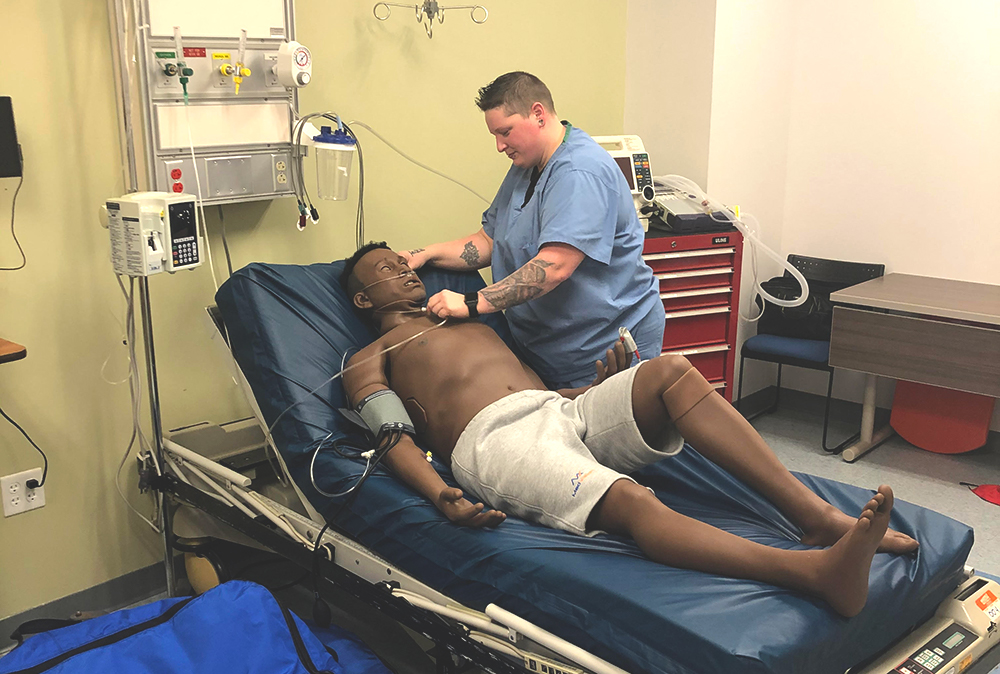
While healthcare simulation educators have been challenged to find new, innovative ways to reach learners during the coronavirus pandemic, they have also struggled to ensure these methods are as realistic as possible. This includes ensuring that patient diversity exists across healthcare simulators, medical simulation modules and other means of virtual learning. With this mind, MedVision has helped to promote diversity across the field of clinical simulation through development of the company’s customizable adult patient simulator, Leonardo. This human patient simulator is capable of being produced in a variety of skin tones to help create the most high-fidelity simulation experiences possible.
To create a manikin that not only has a realistic skin tone and feel, but also depicts realistic ethnic features, MedVision worked with customers around the world. Today, Leonardo is designed for cardiopulmonary resuscitation performance training, intensive care, and advanced life-support procedures using a large variety of possible medical situations. One of the Leonardo’s most unique features is his ethnic skin, which is realistic in look and feel.
To better serve the needs of a diverse population, the company says educators must take measures to provide learning opportunities that more realistically depict the population and improve competence, as well as racial and ethnic diversity. By embracing cultural competence and diversity in health care, MedVision believes providers can improve the overall quality of care.
“At Quinsigamond Community College, we have multiple healthcare programs that utilize clinical simulation. As part of our diversity inclusion mentality, we have manikins that are from different ethnic backgrounds,” said Brittany Casasanta, a lead registered respiratory therapist at Heywood Healthcare in Gardner, Massachusetts. “We desired to have Medvision create our Leonardo with a darker skin tone to help our students be prepared to treat patients of all backgrounds and provide culturally responsible care.
“At MedVision, we pride ourselves on listening to customers and making product modifications to best meet market demands. Our manufacturing capabilities allow us to make product changes sometimes within days – compared to weeks, months, or even years that is standard in the industry. To ensure we had realistic, ethnic and diverse manikins, we reached out to customers for input and made several changes to skin tone and features, before we believed he was ready to go to market,” said MedVision CEO Yulia Melnikova.
Other features that set Leonardo apart in the marketplace are his weight and articulation. His weight is more realistic to that of a human. That heightens the realism of patient movement, extrication, and other scenarios. Leonardo has realistic articulation at the waist allows him to be moved and poised in positions that others simply can’t. The patient simulator can realistically sit up straight for positioning in a chair, wheelchair, stretcher, bed – or even a car. He also has realistic articulation at all of his joints, limbs and extremities. He can be easily posed and dressed.
“Currently, [our] Leonardo is set up in a hospital-style environment for the respiratory care and nursing students. The respiratory students can work on postural drainage with this manikin because of his fully articulating joints,” Casasanta shared. “He can sit upright on the edge of the bed to receive manual chest pt as well.”
Leonardo is also a versatile manikin that can be used in a variety of settings and in a variety of scenarios. For example, he can be used in pre-hospital settings, nursing schools, hospitals, military settings and others. He is ideal for pre-hospital learning environments to help fire and EMS personnel train on intubation, sudden cardiac arrest, CPR, etc.
“When it comes time for the paramedic student to complete trauma simulation, Leonardo will be set up in the hallway or a mock living room with a complete environment and manikin moulage,” Casasanta explained. “The fact that he is portable, it allows for realistic scenarios that paramedic students will encounter when working out in the real world as licensed paramedics.”
MedVision says that the company will continue to listen to customer / market needs and requests to address diversity and ethnic challenges in their healthcare simulation training labs. They are looking for more realistic skin look and feel and more realistic features, which the company is happy to address and provide. MedVision uses the same process in creating their full line of simulators, to include a pediatric simulator, Arthur and an infant simulator, Mia. They also have an adult and pediatric sounds task trainer, MATT (MedVision Auscultation Task Trainer.) These products have been well received and MedVision is looking forward to future product developments.
More About MedVision
MedVision is a global company in existence more than a decade specializing in designing and manufacturing high-fidelity patient and surgical simulators. MedVision works closely with healthcare professionals around the world to create successful simulation products that impact the quality and safety of patient care and improve patient outcomes. MedVision recently opened their United States Headquarters in Tampa, Florida.
The company’s designs and leading-edge technologies define a range of adult, pediatric, neonatal and surgical simulators. MedVision is proud to work closely with healthcare professionals around the world to create successful simulation programs that will impact the quality and safety of patient care and help to improve patient outcomes.